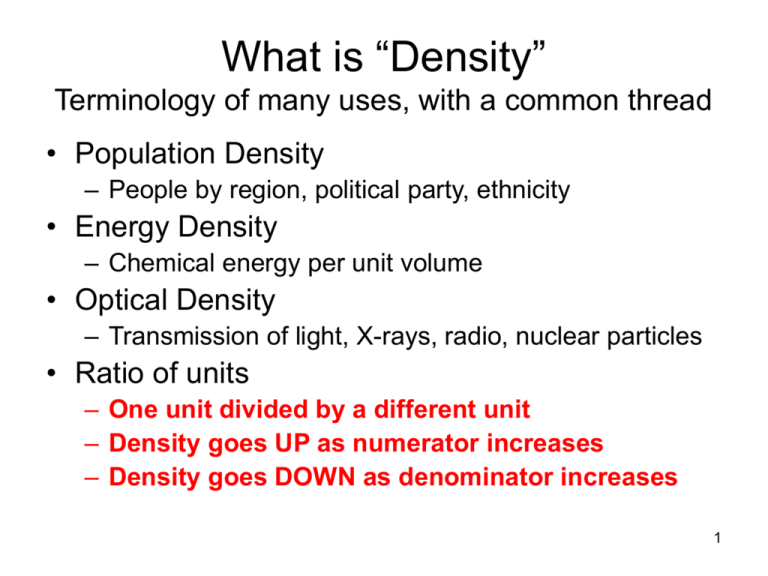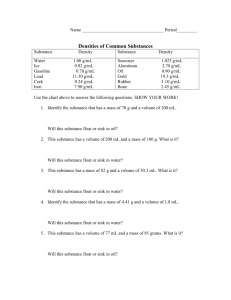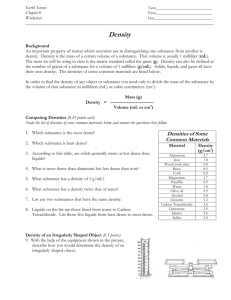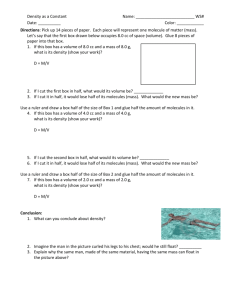04_DensityLab_19feb13
advertisement

What is “Density” Terminology of many uses, with a common thread • Population Density – People by region, political party, ethnicity • Energy Density – Chemical energy per unit volume • Optical Density – Transmission of light, X-rays, radio, nuclear particles • Ratio of units – One unit divided by a different unit – Density goes UP as numerator increases – Density goes DOWN as denominator increases 1 The current Population Density on earth is 13 people per square kilometer 2 Population Density, people/sq.mile 3 Homicide Density, murders/location Santa Cruz sends patrol cars where the crimes most likely 4 Economic Density, $/square.km 5 Energy Density, watts/kg most common batteries are cylindrical, “primatic” are rectangular two density measures, energy per weight, energy per volume 6 Bone Density, opacity/volume 7 Probability Density, items/location Apples falling from tree, electrons around Hydrogen 8 Dice Probability Density,Value/throw 36 combinations for sum of two die (face value 1 to 6) Rolling a 7 is highest probability (4+3, 3+4, 2+5, 5+2, 1+6, 6+1) 9 Matter & Energy Ratios 10 The Common Thread … measurement quantity using ratios Chemistry Applications – Optical Density (absorbance, transmittance) • IR analysis, spectra photometry • X-Ray images, optical filters – Mechanical (or Geometrical) Density • Intensity per unit area (people/km^2) • Mass per unit Volume (grams/cm^3) – Water is reference of 1 gram/cm^3 – This is the subject of today’s experiment 11 Seven Basic SI Measurements • • • • • • • Mass = Kilogram Length = Meter Time = Second Temperature = degrees Kelvin Quantity of matter = mole Energy Rate = Ampere Light Energy = Candela 12 Derived Units • Area is a 2-dimensional multiplication of lengths. An acre was defined by length of one furlong (220 yards) and breadth of one chain (22 yards), or 4,840 square yards per acre. Square feet are still common in US • Volume a 3-Dimensional concept, based on (length)3 Early definitions were arbitrary (quart, gallon), “metric” system is based on 1 Liter = 1000 cm3 • Density is mass per unit volume. The initial metric system “CGS” (Centimeter, Gram, Second) used water defined as 1.0 gram per cubic centimeter. CGS evolved to MKS (Meter, Kilogram, Second), now called SI (System Internationale) or ISO (International Standards Organization) units system. 13 Basic CGS metric scheme Preceded SI / ISO system of units (cm vs meter) 1 cm^3 = 1 milliliter = 1 gram H2O 14 Density • Mass/Volume defined by water – Grams/cm^3 =1 (1 gm / milliliter) – Kilograms/liter = 1 (1000 gm /1000 ml) – 1000 kilogram/meter^3 (1000 liter/meter^3) • Density is important on a “water planet” – Objects >1 gm/ml sink in water, <1 gm/ml float – Ships float due to mass < water displacement – Ice floats due to expansion <4oC • If not, ice would sink … life on planet changes 15 Ice and Water 16 What’s the difference, MKS & CGS • Kilograms / Meter^3 in MKS units – MKS = Meter, Kilogram, Second • Same concept as grams / cm^3 in cgs units – CGS = Centimeter, Gram, Second – 1 gram =0.001 kilogram = 10-3 kg – 1 cm^3 = 0.01m*0.01m*0.01m =10-6 m^3 – 1 g/cm^3 =10-3gram/10-6m^3 = 1000 kg/m^3 17 Density of Water • when water cools, it tends to stack in a crystalline lattice configuration that stretches the length of the bond. • The rigidity of ice crystalline structure ensures that each given H2O molecule has fewer neighbors, and thus the solid is less dense. This effectively reduces the density when ice is formed under standard conditions. 18 Density Triangle Mass=D*V, Density=M/V, Volume=M/D (DMV ≠ Dept of Motor Vehicles !) 19 Density of material groups (water is 1000 kg/m^3) 20 21 Table 3-4, p. 82 Balsa, the least dense Wood internal structure is mostly air, from South America Density is 0.16 gm/cm^3, a person can carry an entire tree! 22 Density of the Earth 23 Earth composition by Density 24 Detecting mass with density? • Gravity attracts objects by distance and amount of mass. • For identifying the location of a more dense ore body (iron, uranium) gravitational acceleration is slightly greater over the ore (more mass, same volume) than not. 25 What “floats your boat”? • Archimedes principle – Less dense object floats in more dense medium – Wood therefore floats on water, iron sinks – Displacement is key concept • Iron ship full of air, average density <1 gm/cm^3 – so it floats in water of density ≈ 1 gm/cm^3 • Must consider combined mass and volume – Lead glued to cork … calc the sum of mass + volumes – Floats if mass/volume < 1 gm/cm^3 26 Flotation applies to Gases as well • You don’t need tables of density values – Periodic chart has all the data we need – 1 mole of ANY gas occupies 22.4 liters • Balloon will float in air with less dense gas – Hydrogen (H2) is 2.016 gm/(mole=22.4 liters) – Helium is 4 grams/(mole=22.4 liters) – Air is about 29 grams/(mole=22.4 liters) – Carbon Dioxide is 44 gm/(mole=22.4 liters) 27 Helium and/or Hot Air Density difference provides the lift 28 Lawn Chair Larry 1993 Darwin Award Honorable Mention Award (this stunt did not kill him, otherwise a full award) 29 Hot Air Balloons more practical • Helium difficulties – Expensive material, need lots of it – must compress to store (or leave balloon full) – Small molecule leaks easily • Hot air more practical – Make it as needed – Inexpensive (burn propane) – … but hot air is hard on the balloon 30 A hot air balloon is partially inflated with cold air from a petrol-driven fan, before the propane burners are used for final inflation. 31 32 33 34 35 36 CS #4 Density Experiment • You measured density in expt. #3 – Density of Water – Density of irregular object • Today we look at relative densities – – – – Less dense materials float on more dense Work with liquids and solids We’ll make a “column” of varying densities We’ll sink and float a golf ball 37 Density • Water all around us, a useful reference – Easy to obtain, purify, & measure • Density is temperature sensitive – Usually expand with rising temperature – Water has a maximum density at 4oC • Water at < 0oC forms ice, which floats • Density defined as 1.0000 gm/cm^3 at 4oC 38 Density • Mass/Volume defined by water – Grams/cm^3 =1 (also defined as 1 milliliter) – Kilograms/liter = 1 (1000x gm and ml) – 1000 kilogram/meter^3 (1000 liter/meter^3) • Density is important on a “water planet” – Objects >1 gm/ml sink in water, <1 gm/ml float – Ships float due to mass < water displacement – Ice floats due to expansion <4oC • If not, ice would sink … life on planet changes 39 Ice and Water 40 Density of Water 41 Experiment Procedure • Measure mass and volumes of 4 liquids – Calculate densities of the liquids • Carefully pour liquids into graduated cylinder – Observe which ones float on others – Blue food color in KBr solution – Red food color in distilled water bottle • Place solid objects in layered column – Where do they float? – What are likely densities, what are materials? • Mix liquids in column – How many layers are left? – Which ones were soluble in each other? 42 Measure densities of 4 liquids • Liquid Volume – Milliliters via graduated cylinder • Liquid Mass – Grams container with – without liquid • Density of liquid – Grams/volume = density – Dimensions are gms/mL (or gm/cm^3) • Repeat for 3 other liquid densities 43 “Stacked” densities, 50mL grad cyl. Add liquids, most dense at bottom, others float in order of density mix the layers … how many layers left, which ones mixed? Least Dense Most Dense Material = Density = Material = Density = Material = Density = Material = Density = 44 Densities of solid objects • Add solid objects to density column – Which layers does it float between – Density of those two layers? – What is density range of floating object? – What material is it likely to be? 45 Mixing the layers • • • • • Hold thumb over top of grad. cylinder Invert several times to mix liquids How many layers are left? Which ones mixed? How would you tell? – Hint: try some solid objects 46 Golf Ball Flotation • We will calculate theoretical density – Specified mass & specified volume • We will measure actual density – Weight of ball, displaced volume • How do the two compare? • Does ball float on salt solution? – Try it 47 Common Plastics Arranged by Density MATERIAL NAME Shorthand Polypropylene Low Density Polyethylene High Density Polyethylene PP LDPE HDPE Water Water Acrylonitrile Butadiene Styrene PolyStyrene Nylon Polymethyl Methacralate (Acrylic) Polycarbonate Polyvinyl Chloride Polyethylene Terephthalate ABS PS Nylon PMMA PC PVC PETE recycle grams grams code # per cm^3 min 0.90 0.91 0.94 1 1.01 1.03 1.06 1.18 1.20 1.32 1.35 per cm^3 max 0.92 0.93 0.96 1 1.04 1.06 1.15 1.18 1.22 1.42 1.38 48 5 4 2 ABS 6 none none 7 3 1 Plastics with applications recycle grams Arranged by Density code # MATERIAL NAME Shorthand Polypropylene Low Density Polyethylene High Density Polyethylene PP LDPE HDPE Water Water Acrylonitrile Butadiene Styrene PolyStyrene Nylon Polymethyl Methacralate (Acrylic) Polycarbonate Polyvinyl Chloride Polyethylene Terephthalate ABS PS Nylon PMMA PC PVC PETE 5 4 2 ABS 6 none none 7 3 1 per cm^3 min 0.90 0.91 0.94 1 1.01 1.03 1.06 1.18 1.20 1.32 1.35 grams per cm^3 max 0.92 0.93 0.96 1 1.04 1.06 1.15 1.18 1.22 1.42 1.38 applications lowest density, chem resistant 1% of plastic used, heat sealed bags 47% of plastic bottles no recycling code, came after definitions developed foam cups, plastic "keep boxes", brittle but cheap tough & slippert plastic, combs, some engineering use "Plexiglas", paint, brittle, poor chem resistance "7" is a catchall or "others", made from BPA plastic pipe, 2% of bottles, window frames, automotive 48% of bottles, soft drinks, beer, juice, veg oil 49





